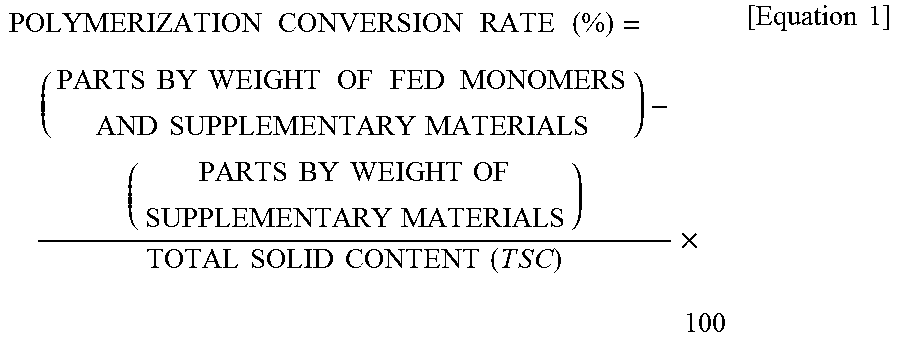Method of preparing heat-resistant resin, heat-resistant resin and heat-resistant abs resin composition
a technology of abs resin and heat-resistant resin, which is applied in the field of methods, can solve the problems of deterioration of intrinsic heat-resistant characteristics, decrease of workability, and decrease of workability, and achieves the effects of reducing the amount of polymerized coagulum, reducing workability and productivity, and high polymerization conversion ra
- Summary
- Abstract
- Description
- Claims
- Application Information
AI Technical Summary
Benefits of technology
Problems solved by technology
Method used
Image
Examples
example 1
[0077]Based on 30 parts by weight of the latex S1 (based on solid) polymerized in (a) seed polymerization step 1, 150 parts by weight of deionized water, 45 parts by weight of α-methylstyrene, 10 parts by weight of acrylonitrile along with 0.5 parts by weight of lauric acid potassium, 0.2 parts by weight of alkenyl succinate potassium (product name: Latemul ASK), 0.3 parts by weight of n-dodecyl mercaptan, and 0.2 parts by weight of an α-methylstyrene dimer were fed to a nitrogen-substituted reactor batchwise and stirred at 50° C. for minutes. Subsequently, an oxidation-reduction catalyst composed of 0.02 parts by weight of t-butyl hydroperoxide, 0.035 parts by weight of dextrose, 0.06 parts by weight of sodium pyrophosphate, and 0.0015 parts by weight of ferrous sulfate was added thereto batchwise and polymerization was carried out while elevating temperature to 70° C. for one hour. Here, a polymerization conversion rate was about 85%.
[0078]Subsequently, an emulsion composed of 100...
example 2
[0081]An experiment was carried out in the same manner as in Example 1, except that the initially added latex S1 was fed in an amount of 80 parts by weight (based on solid) and feeding was carried out in accordance with compositions summarized in Table 2 below.
example 3
[0082]An experiment was carried out in the same manner as in Example 2, except that S2, as an initially fed latex, was used instead of S1 and feeding was carried out in accordance with compositions summarized in Table 2 below.
PUM
| Property | Measurement | Unit |
|---|---|---|
| glass transition temperature | aaaaa | aaaaa |
| heat deflection temperature | aaaaa | aaaaa |
| Tg | aaaaa | aaaaa |
Abstract
Description
Claims
Application Information
 Login to View More
Login to View More - R&D
- Intellectual Property
- Life Sciences
- Materials
- Tech Scout
- Unparalleled Data Quality
- Higher Quality Content
- 60% Fewer Hallucinations
Browse by: Latest US Patents, China's latest patents, Technical Efficacy Thesaurus, Application Domain, Technology Topic, Popular Technical Reports.
© 2025 PatSnap. All rights reserved.Legal|Privacy policy|Modern Slavery Act Transparency Statement|Sitemap|About US| Contact US: help@patsnap.com

